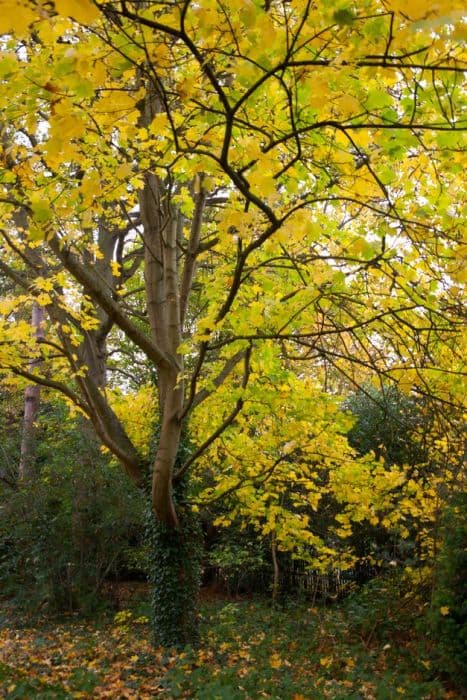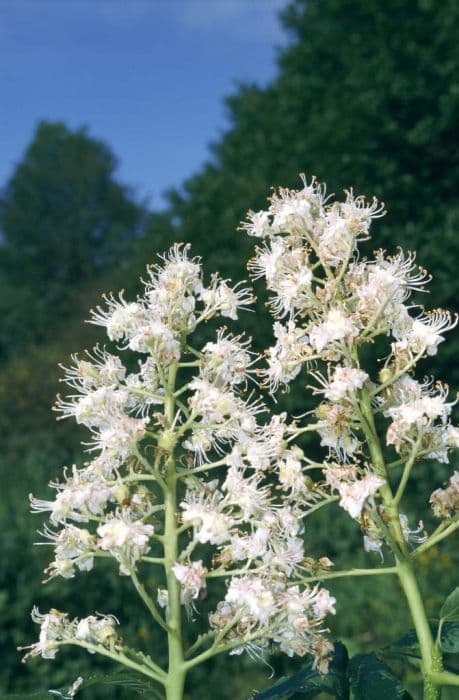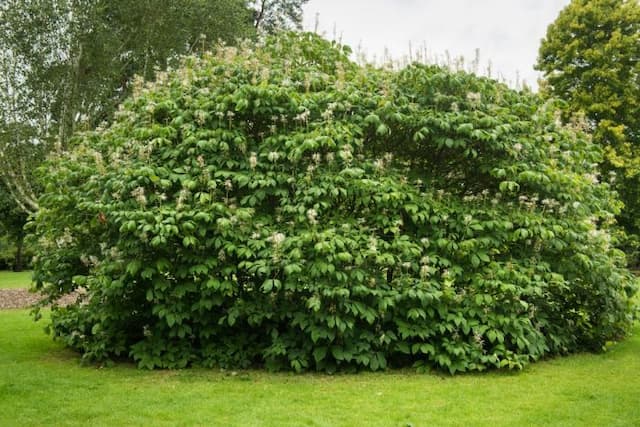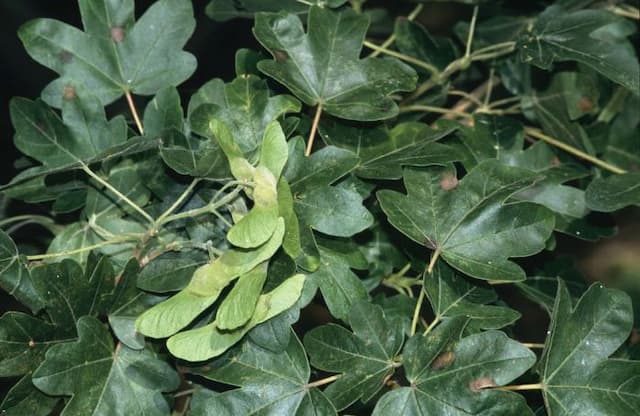Red maple 'Scanlon' Acer rubrum 'Scanlon'

ABOUT
'Scanlon' is a medium-sized, upright, broadly columnar tree to around 20m tall with lobed dark green foliage that turns bright red in autumn. Clusters of small, red flowers are borne on the bare branches in spring
About this plant
 Names
NamesFamily
Sapindaceae
Synonyms
Red Maple, Scarlet Maple, Soft Maple, Carolina Red Maple, Swamp Maple
Common names
Acer rubrum 'Scanlon'.
 Characteristics
CharacteristicsLife cycle
Perennials
Foliage type
Deciduous
Color of leaves
Green
Flower color
Red
Height
40-50 feet (12-15 meters)
Spread
25-35 feet (7.5-10.5 meters)
Plant type
Tree
Hardiness zones
3-9
Native area
North America
Benefits
 General Benefits
General Benefits- Aesthetic Appeal - Acer rubrum 'Scanlon', commonly known as the Red Maple, has a striking crimson-red fall color that serves as a visually appealing feature in any landscape.
- Shade Provider - The tree grows to a significant size, offering ample shade in parks, yards, and other outdoor spaces.
- Wildlife Attraction - It provides food and habitat for various species of birds and small mammals, supporting local biodiversity.
- Seasonal Interest - It offers year-round interest with spring flowers, summer greenery, fall foliage, and even attractive winter branch patterns.
- Adaptable Growth - The Red Maple adapts to a wide range of soil types and conditions, making it a versatile choice for different environments.
- Erosion Control - Its root system helps stabilize soil and prevent erosion, especially in sloped or watershed areas.
- Urban Tolerant - The Red Maple is tolerant of pollution and compacted soil, making it suitable for urban settings.
- Climatic Resilience - It is resilient to a range of climatic conditions, including cold temperatures and varying amounts of rainfall.
 Medical Properties
Medical PropertiesThis plant is not used for medical purposes.
 Air-purifying Qualities
Air-purifying QualitiesThis plant is not specifically known for air purifying qualities.
 Other Uses
Other Uses- Acer rubrum 'Scanlon', commonly known as Red Maple, can be tapped for syrup, although it is not as commonly used as the Sugar Maple.
- The wood of the Red Maple is sometimes used in furniture-making, though it's not as valuable as other maples due to its tendency to twist when drying.
- You can use the Red Maple's bark in landscape mulching for a natural and aesthetically pleasing ground cover.
- The dried leaves of the Red Maple can be added to compost piles to enrich the compost with organic matter.
- Red Maple branches can be utilized as natural stakes or support for other plants in the garden.
- The tree can be grown as a windbreak or privacy screen in large landscapes, due to its dense foliage.
- Red Maple's vibrant fall leaves can be collected and used in crafts for decorations, such as wreaths or table centerpieces.
- Its fast-growing nature makes Red Maple suitable for use in reforestation and erosion control projects.
- Young Red Maple saplings can be shaped and trained for bonsai projects.
- The tree can act as a host plant for various butterfly and moth species, contributing to biodiversity.
Interesting Facts
 Feng Shui
Feng ShuiThe Red Maple is not used in Feng Shui practice.
 Zodiac Sign Compitability
Zodiac Sign CompitabilityThe Red Maple is not used in astrology practice.
 Plant Symbolism
Plant Symbolism- Strength: Red Maple, including the 'Scanlon' cultivar, is often associated with strength due to its sturdy wood and its ability to thrive in a variety of conditions.
- Beauty: The 'Scanlon' variety of Red Maple is known for its attractive, upright growth form and vibrant red foliage, making beauty a key symbolic trait.
- Change: Red Maples represent change because they are one of the first trees to change color in the fall, signaling the transition from one season to another.
- Balance: The Red Maple has leaves that are uniquely shaped, with lobes that are balanced and symmetrical, symbolizing balance in life.
- Wisdom: In some cultures, Red Maples are considered a symbol of wisdom, as trees are often ancient and witness to the passing of time.
- Endurance: The ability of the Red Maple to adapt and survive in different climates makes it a symbol of endurance and resilience.
 Water
WaterThe Red Maple should be watered deeply once or twice a week during its first growing season to help establish an extensive root system. After establishment, watering can be adjusted to a general guideline of once a week, providing 1.5 to 2 gallons of water each time, depending on the weather conditions. During hot, dry periods, increase watering frequency to every 4-5 days. Reduce watering in the fall before the tree goes dormant, and during winter, only water if the soil is dry and it’s a snow-free period. Avoid overwatering as it can lead to root rot.
 Light
LightThe Red Maple thrives in full sun to partial shade. It prefers to be planted in a location where it can receive at least 4 to 6 hours of direct sunlight daily. The ideal spot for the Red Maple would be one that offers morning sunlight and some afternoon shade, particularly in the hotter regions to prevent leaf scorch.
 Temperature
TemperatureThe Red Maple is hardy and can tolerate a wide range of temperatures but generally prefers areas with a temperature range of 40°F to 90°F. It can handle minimum winter temperatures down to -30°F and maximum summer temperatures up to 100°F. The ideal growing conditions for the Red Maple would be in regions with moderate temperatures that avoid extremes.
 Pruning
PruningPruning the Red Maple is important to maintain its shape and to remove any dead or damaged branches. The best time to prune is during the late winter or early spring before the sap begins to flow. Pruning should occur every 3 to 5 years to help encourage healthy growth and maintain the tree's structure. Always use clean, sharp tools to make clean cuts.
 Cleaning
CleaningAs needed
 Soil
SoilRed Maple 'Scanlon' thrives in acidic to neutral soil with a pH of 4.0 to 7.0. A well-draining soil mix composed of loam, compost, and a small amount of sand or perlite facilitates healthy root growth. Ensuring the soil is rich in organic matter will help maintain moisture and provide necessary nutrients.
 Repotting
RepottingRed Maple 'Scanlon' trees are typically landscape plants and do not require regular repotting. However, if grown as container plants, young trees should be repotted every 2-3 years to accommodate their growing root systems.
 Humidity & Misting
Humidity & MistingRed Maple 'Scanlon' prefers outdoor conditions where humidity is naturally regulated. They do not require specific humidity levels but grow well in average atmospheric humidity common in their native habitat.
 Suitable locations
Suitable locationsIndoor
Plant in well-lit room, with large pot and moist soil.
Outdoor
Plant in acidic soil, full sun to partial shade, mulch.
Hardiness zone
4-9 USDA
 Life cycle
Life cycleAcer rubrum 'Scanlon', commonly known as Red Maple 'Scanlon', begins its life as a dormant seed, which typically requires a period of cold stratification to break dormancy and germinate. Once the seed germinates in spring, a seedling emerges, growing roots and a shoot that develops into a juvenile sapling. The sapling stage is characterized by rapid vertical growth and limited branching as the plant focuses on establishing a strong trunk and root system. As the tree matures, it enters the adult stage, producing a dense, columnar crown with vibrant red foliage in the fall and small red flowers in early spring, eventually leading to winged samaras (seeds). These seeds are then dispersed by wind, allowing the potential for new trees to grow in suitable environments. In its full maturity, the Red Maple 'Scanlon' can live for many decades, up to 100 years or more, and throughout this time, it periodically produces seeds to continue the species.
 Propogation
PropogationPropogation time
Early Spring
Propogation: The Acer rubrum 'Scanlon', commonly known as the 'Scanlon' Red Maple, is best propagated through the collection and sowing of its seeds. The optimal time for this process is in the fall, immediately following seed maturity, when they can be harvested directly from the tree. Propagation via seeds involves cleaning the seeds and stratifying them by cold treatment, typically in a refrigerator, for about 60 to 90 days to break dormancy. After stratification, the seeds are sown in well-drained soil and lightly covered. They should be kept moist and in a location with bright, indirect sunlight. Seedlings generally emerge in the spring and can be transplanted outdoors once they've developed a robust root system and the threat of frost has passed. Patience is key in this process, as it can take several years for a seed-grown 'Scanlon' Red Maple to reach maturity.









